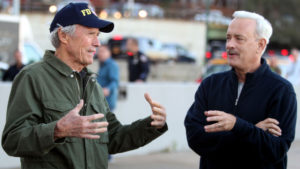| BlueSky Business Aviation News | ||||||||||||||
|
||||||||||||||
Remember big snoozers like Tuskeegee Airmen, Flight or Pearl Harbor? Of course, there have been a few outstanding films over the years like 12 O’Clock High and the Battle of Britain. But the good ones are few in number. When Clint Eastwood’s “Sully” began the other night, I was hoping one of my favorite directors might get this one right. 90 minutes later, I left the theatre believing that anyone, with even the tiniest interest in aviation, would walk away feeling their money was well spent. Eastwood got it right. Sully’s not a disaster film. It’s watches almost a bit like a documentary . . . a very good documentary. That’s because Eastwood’s film dissects more than just the 208 seconds, between the takeoff of USAir flight 1549, radio callsign Cactus 1549, and its landing on the Hudson River. The dream sequence that opens the film tells you more about where the film’s headed than anything else. Cactus 1549’s water landing, crash, arrival or whatever you call it, represents the greatest mixes of skill and luck known to aviation in a long time.
What I think really what makes Sully the first great aviation film I’ve seen in a long time is the opportunity it offers us to get inside Capt. Sullenberger’s head as he wrestles with the decisions he and Skiles made in those seconds after they plowed through a huge flock of Canada Geese. It happened in the movie, just the way it does in real life. Someone in the cockpit says “birds,” and a fraction of a second later you either hit them, or miss them. There’s seldom a chance to swerve out of the way. Right after both of the A320s engine’s flamed out, there are some agonizingly long seconds of silence in the cockpit. Some people in the movie house actually yelled out , “Why isn’t he doing something? He’s just sitting there.” Experienced pilots of course, realize Sully was doing something, but all the analysis, like “We can’t really be seeing a dual flameout at low altitude,” was going on in his head and also showed on his face. Some of the best teaching moments for the public, if I may call them that, happen during the NTSB’s public hearings in which Eastwood shows Sully and Skiles sitting alone at a table like the defendants in a major trial.
One of the most poignant scenes comes during the public hearings comes when an NTSB official finishes listening to the 208 seconds of cockpit voice recorder from Cactus 1549. He looks at the two pilots and admits the power of what he’d just heard and the irony that he normally never has a chance to listen to these recordings with the actual pilots involved, for obvious reasons. In places the film is almost surreal with Sully showing us how pilots think both before and after, when they must live with the results of their decisions . . . decisions often made in the heat of a battle that few ever experience. We see the anguish and self-doubt Sully experienced for months after the accident knowing that after 40 years of flying he was ultimately going to be judged on 208 seconds of his career. What really makes this 93 minutes worthy of anyone’s time and money though is that Eastwood never whacks viewers over the head with sensationalistic scenes. He prefers to, if anything, understate what happened to Cactus 1549 that day, perhaps a bit like Capt. Sullenberger himself understated his own role in the Miracle on the Hudson. Sully just said he and Skiles were doing their jobs. What Eastwood does do is let us spend a little time linked up with Capt. Sullenberger’s mind, just enough, I think, to quickly let viewers connect the dots to reach their own moment of clarity. Sully - Directed by Clint Eastwood and Starring Tom Hanks, Aaron Eckhart and Laura Linney - is currently on general release in the United States and opens in the United Kingdom on December 2nd. More release dates.
|
||||||||||||||




